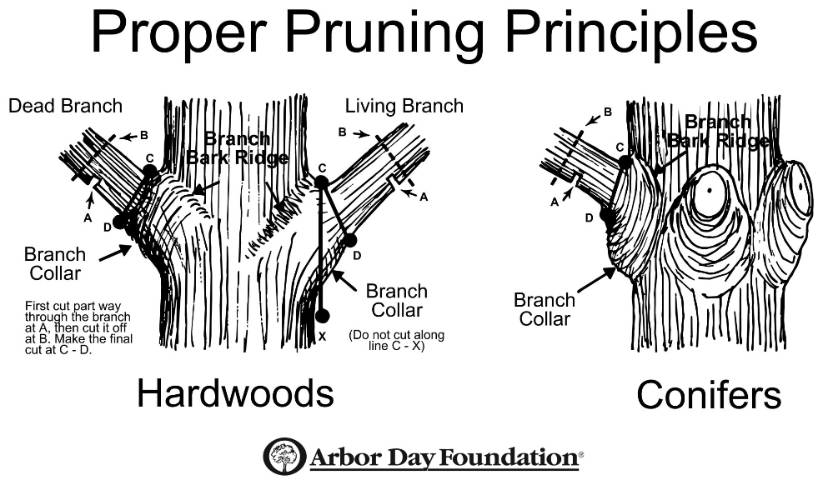Pruning Deciduous Trees and Shrubs
Pruning is essential for attractive, healthy trees and shrubs and improves the quality of flowers, fruit, and foliage. The best way to avoid difficult pruning jobs is to plan ahead; select plants that will fit available space after the plants have matured to their maximum size.
Reasons for Pruning
Training the plant: Some pruning may be necessary at the time of planting to shape your tree or shrub. Broken, crossing, and pest‑ infested branches should be removed, but avoid excessive pruning at transplanting as it tends to retard plant growth and inhibit survival.
Maintaining plant health: Pruning is vital for removing dead, dying, or diseased wood. Any dying branch or stub can be an entry point or build‑up chamber for insects or diseases which can readily spread to other parts of the plant.
Improving plant quality: Pruning reduces the amount of wood in trees and shrubs, and this diverts energy into the production of larger, though possibly fewer, flowers and/or fruit. Properly timed pruning will increase the production of wood that will bear flowers, improving the quality of fruit, foliage, and stems as well.
Regular pruning is often employed to restrict plant growth where space is limited. To reduce unnecessary labor, however, plants should be selected that will not exceed allotted space.
Tools
Choosing the proper tools is important for successful pruning. For a branch one‑half inch or less in diameter, small hand pruners are best. For branches up to 2 inches, use long‑handled loppers. Hard‑to‑reach cuts require pole pruners or pole saws. Use manual hedge shears or power shears for formal hedges. Hand pruning saws are useful when branches are close together.
Disinfect tools with chlorine bleach diluted in water (1:9) or alcohol after each cut on diseased wood.
Timing
Most pruning is done in late winter or early spring to give the maximum time for the wounds to heal. However, to get the best flowering from plants that produce blooms in the spring, prune soon after the flowers die. Flower buds for the next year will develop on new growth during the summer. Summer‑flowering plants develop flower buds on new shoots growing in the spring. Consequently, these plants should be pruned after the coldest part of winter. Dead or diseased wood should be removed whenever the problem is noticed.
Begin pruning at planting to train the plant and avoid large pruning jobs later. Trim damaged roots and rubbing branches. Plants purchased from a reputable nursery were pruned as they grew during production, and should require little or no pruning when transplanted to your landscape.
Evergreens don't need as much pruning as deciduous plants and should not be cut back at planting.
Cuts
Heading back removes part of a limb or branch. They induce side buds to sprout and can be used to alter the shape of the plant. Make the cut just above a healthy bud, pointing in the direction you want the branch to grow. Make slanted cuts to promote healing and prevent the collection of water on the cut. Thinning cuts remove entire branches at their junction with another branch or the trunk, reducing the number of interior limbs. This opens the plant to sunlight and air and can reduce overall size.
Most plants respond best to selective pruning; a combination of thinning and heading cuts. This is healthier for the plant and gives a more natural appearance.
SPECIAL CONSIDERATIONS
Shrubs
Renewal pruning is used on multiple‑stemmed plants like forsythia. Young growth produces more vigorous flowers, so each spring after flowering, remove one third of the oldest and tallest stems near ground level to encourage development of new stems.
Hedges
A natural shape is best for plants. Formal shearing of hedges causes vigorous growth on the outside which shades the interior, leaving a "dead zone" that can't produce new shoots. If you must shear, make the hedge wider at the bottom and sides slanting. Thin out individual branches to open the plant to sunlight.
Trees
Never top, or dehorn, a tree, where all branches are cut close to the trunk. This is unhealthy for the tree and, if the tree survives, a heavy flush of vertical suckers will develop.
Remove limbs with angles of less than 30 degrees from the trunk. If not removed, they may split as the tree grows. A branch should be cut flush with the branch collar, not the trunk. The branch collar is a usually swollen area where the branch joins the trunk. It contains tissue with a chemically protective zone which speeds recovery.
To protect understory shrubs, and for your own safety, tie the branch to a stronger, higher branch. Use three cuts to remove the branch as follows:
- Make a small cut on the underside of the branch about 6 to 12 inches away from the collar and one third of the way through the branch. This prevents the bark from peeling. (A in the attached illustration)
- A little farther out from the first cut, cut down through the branch to remove the entire limb.(B in the attached illustration)
- Finally, cut at branch collar to remove the stub. File any ragged edges from the stub. (C-D in the attached illustration)
Research shows that the branch collar is more effective against decay than pruning sealers, which may actually slow healing.
By Sherri Sanders
County Extension Agent - Agriculture
U of A Division of Agriculture
White County Cooperative Extension Service
411 N. Spruce St, 2nd floor Searcy AR 72143
(501) 268-5394
ssanders@uada.edu
Related Links
